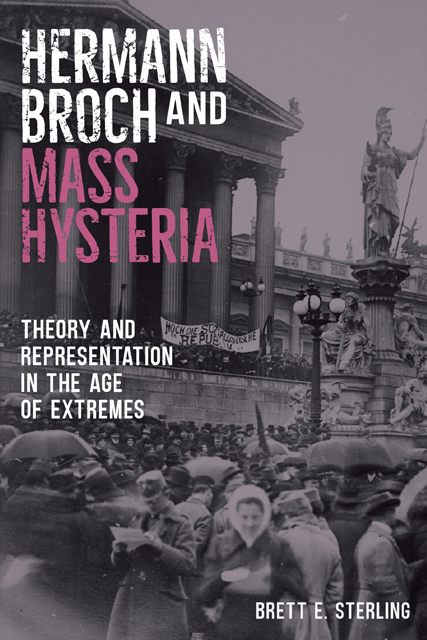Book contents
- Frontmatter
- Dedication
- Contents
- Acknowledgments
- List of Abbreviations
- Introduction
- 1: First Encounters, 1918–1929
- 2: The Power of Literature
- 3: The Mass Takes Shape: Literary Representations
- 4: Theory and Its Discontents: The Massenwahntheorie
- 5: The Threshold of Experience: Die Verzauberung
- Conclusion
- Bibliography
- Index
4: - Theory and Its Discontents: The Massenwahntheorie
Published online by Cambridge University Press: 11 January 2023
- Frontmatter
- Dedication
- Contents
- Acknowledgments
- List of Abbreviations
- Introduction
- 1: First Encounters, 1918–1929
- 2: The Power of Literature
- 3: The Mass Takes Shape: Literary Representations
- 4: Theory and Its Discontents: The Massenwahntheorie
- 5: The Threshold of Experience: Die Verzauberung
- Conclusion
- Bibliography
- Index
Summary
During the early 1930s, literature was the means of expression Broch felt could best access and convey irrational phenomena that evaded direct comprehension. As such a phenomenon, the mass unsurprisingly surfaced in his literary work, with each successive piece bringing the reader closer to the mass itself. From the spectator position of Broch himself in “Die Straße” and Esch in Esch oder die Anarchie, Broch moved to individuals surrounded by, but not incorporated in the mass, including Katharine Hieck in Die Unbekannte Größe and the titular Virgil in Der Tod des Vergil. As the political situation in Europe shifted with rise of National Socialism during the 1930s, a solely literary career—and a purely fictional approach to mass hysteria—began to appear untenable to Broch. The culmination of his philosophical and psychological contemplation on the concept of the mass, the sprawling, but unfinished Massenwahntheorie, marks a departure from literature in favor of theoretical writing. Conceived as a bulwark against the spread of fascism, the theory articulates the relationship between the individual and the mass—which we have seen in literary form over the previous chapters—as well as the psychological mechanisms behind mass hysteria, and in its third part ultimately proposes a regimen of political conversion to democracy to combat mass hysteria as fascism. The Massenwahntheorie looms large in Broch’s body of work as well as in the voluminous scholarship on Broch. As such, the theory has been analyzed, interpreted, and applied by numerous scholars since its partial publication in Wolfgang Rothe’s Gesammelte Werke (1959) and subsequent full publication in Lützeler’s Kommentierte Werkausgabe (1979). Rather than analyze Broch’s complete theory, this chapter will focus on those aspects which are most pertinent to the larger discussion of the mass and mass hysteria as objects of representation. First, the chapter contextualizes the shift in Broch’s work from literature to theory. It then articulates the fundamental separation between the individual and the mass within the Massenwahntheorie, continuing to examine the key phenomena Broch uses to explain mass hysteria as experienced by the individual. Finally, the chapter returns to the mass in an attempt to locate the figure within the theory, while suggesting how the theory can be supplemented by literature, which will then be explored in the final chapter.
- Type
- Chapter
- Information
- Hermann Broch and Mass HysteriaTheory and Representation in the Age of Extremes, pp. 106 - 157Publisher: Boydell & BrewerPrint publication year: 2022



